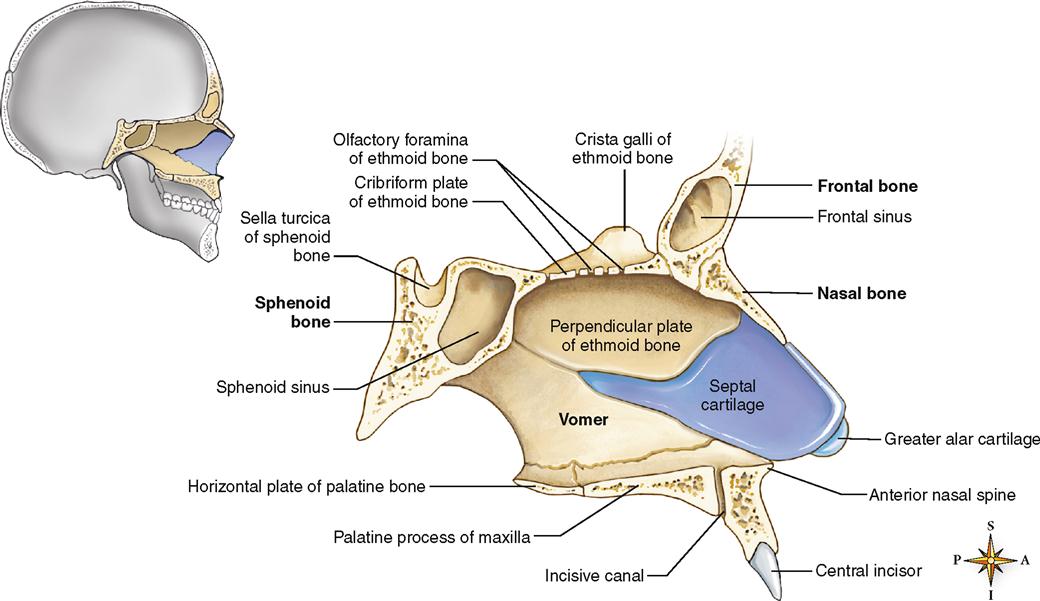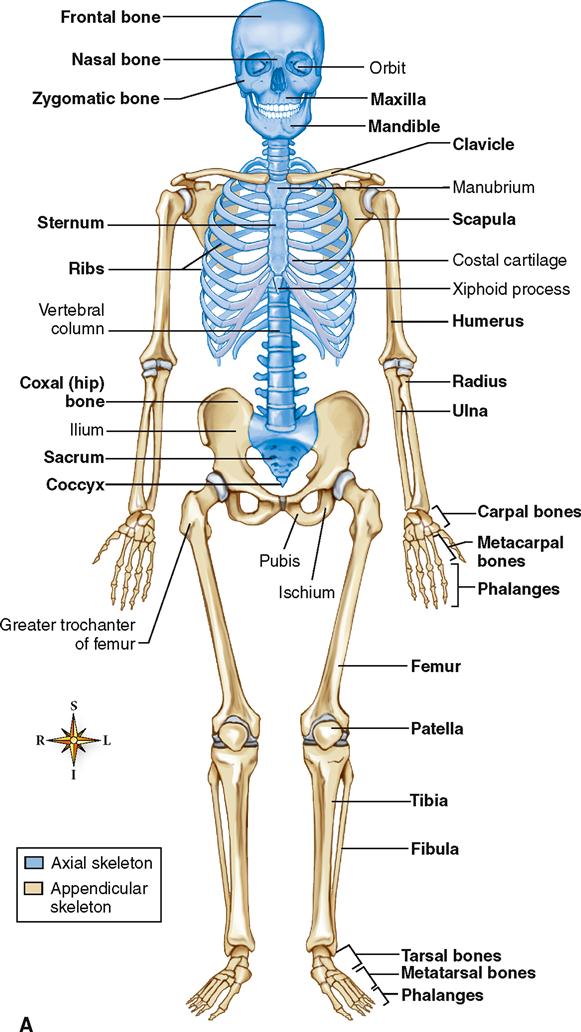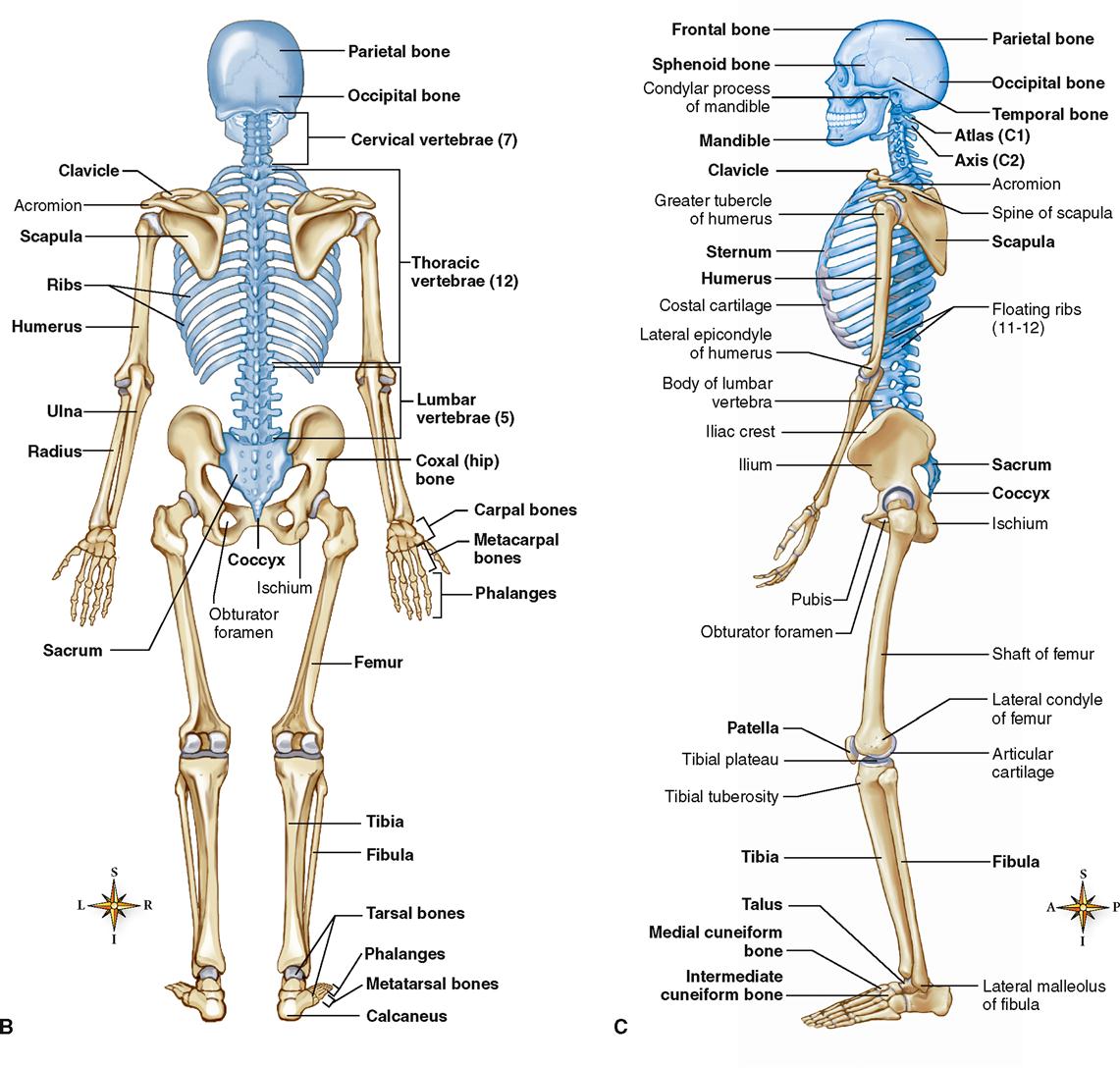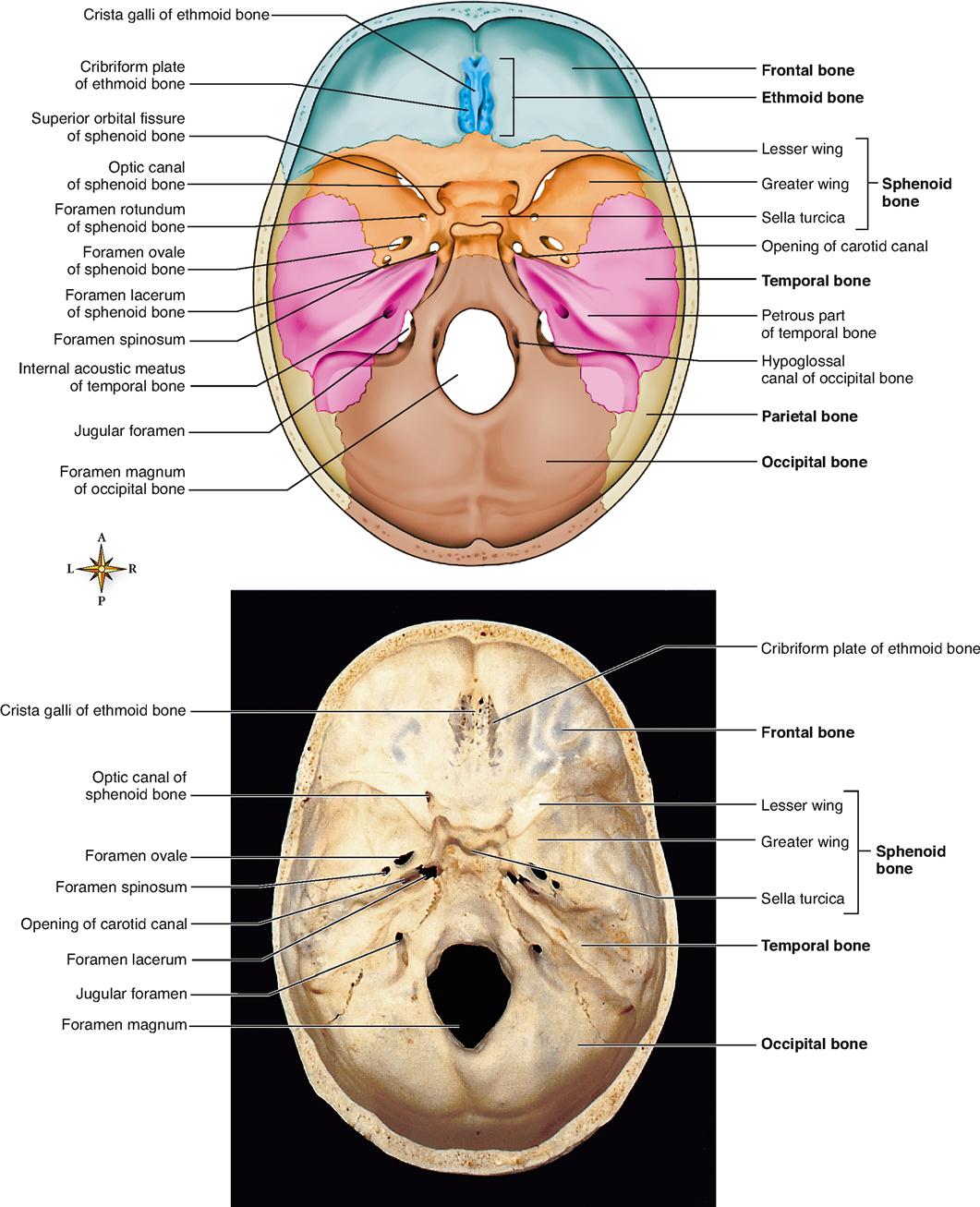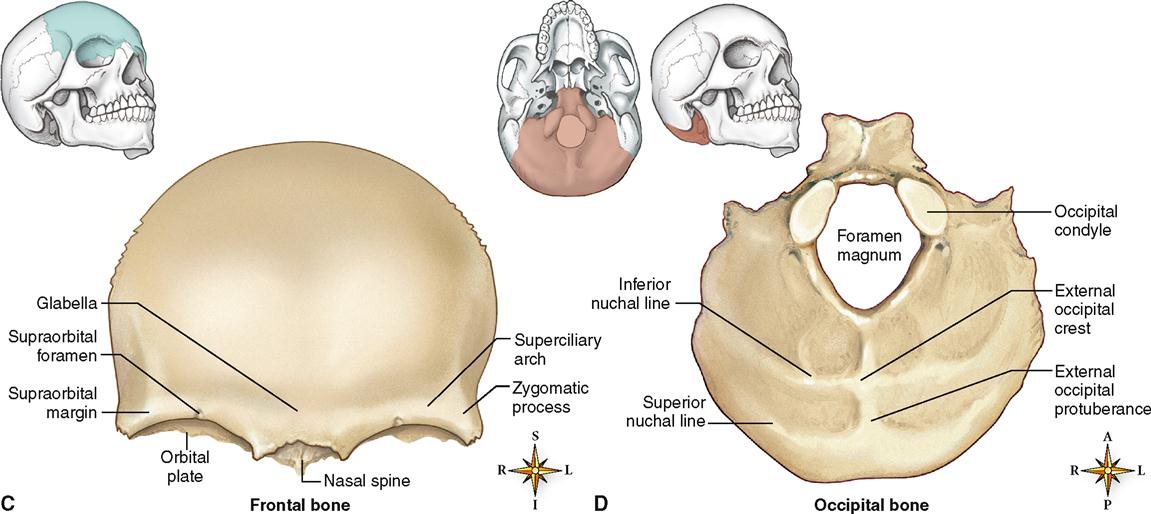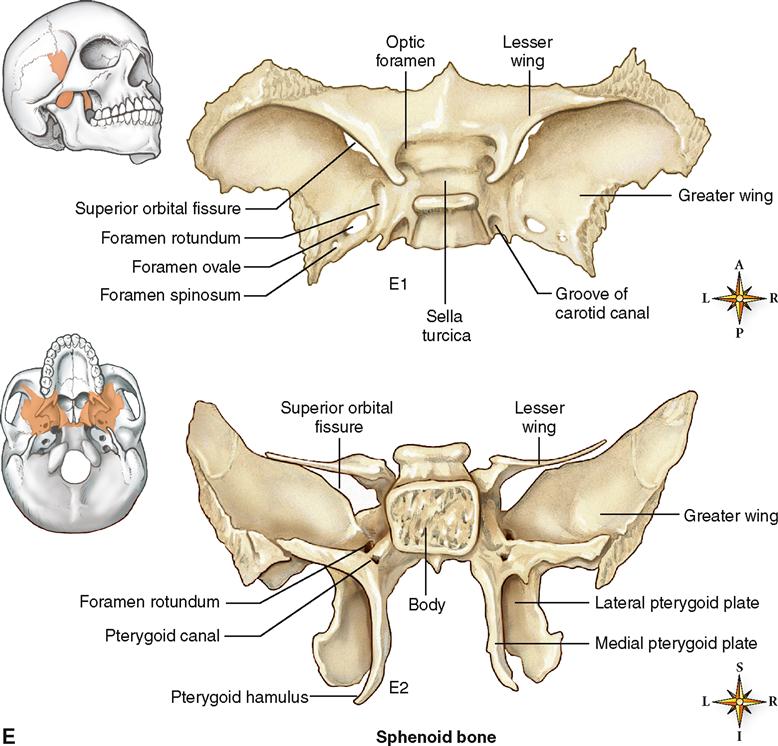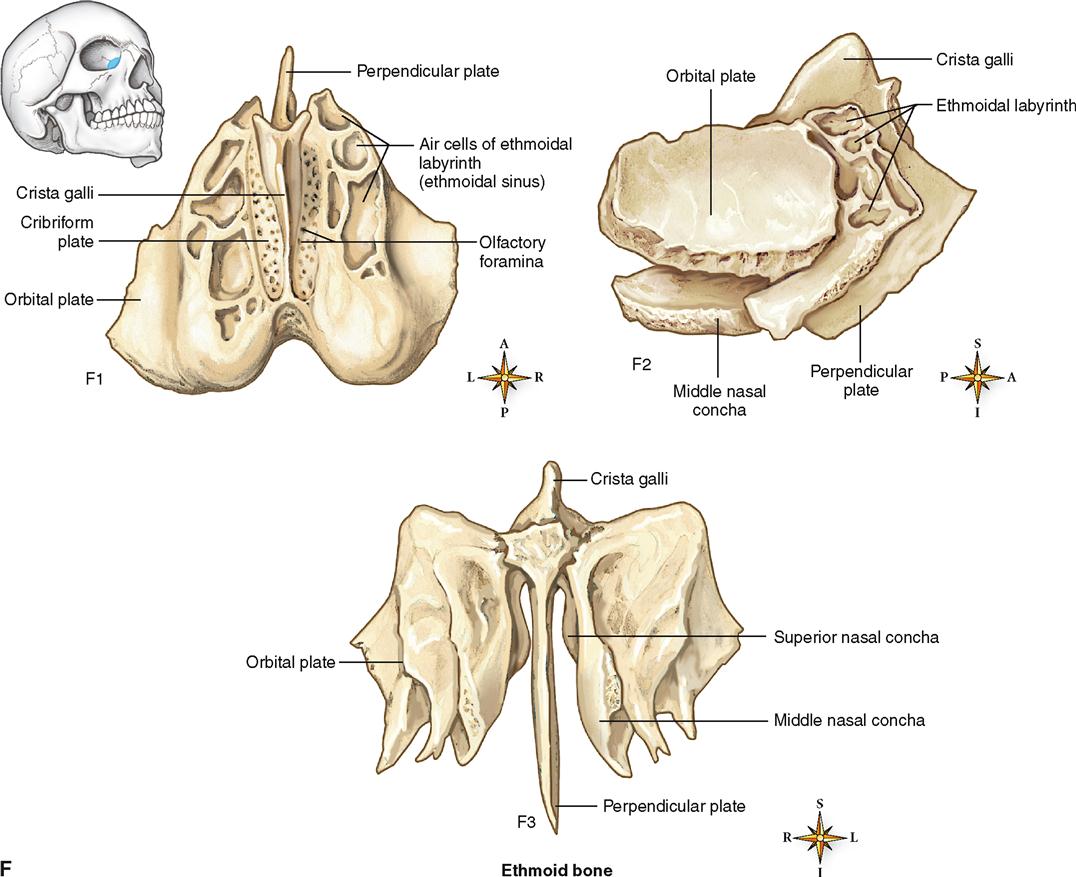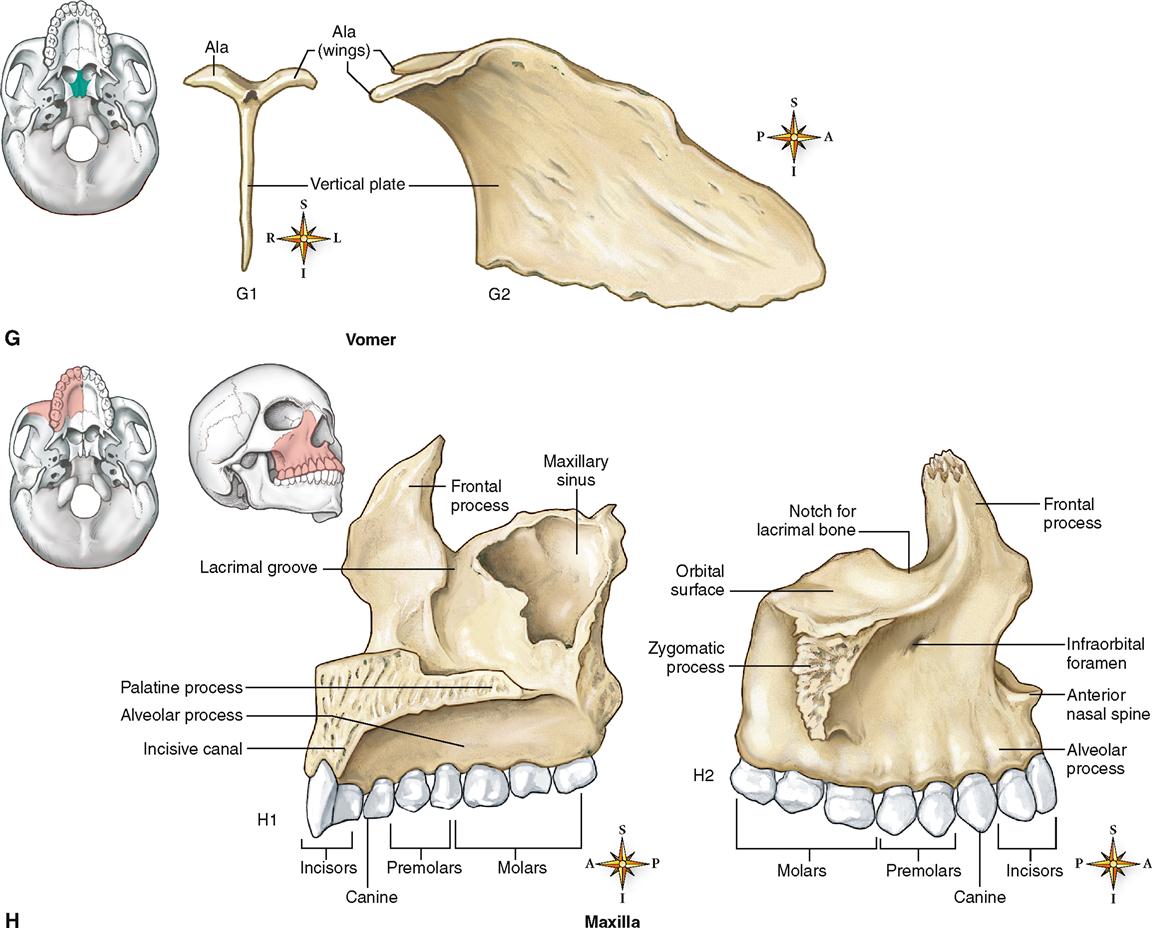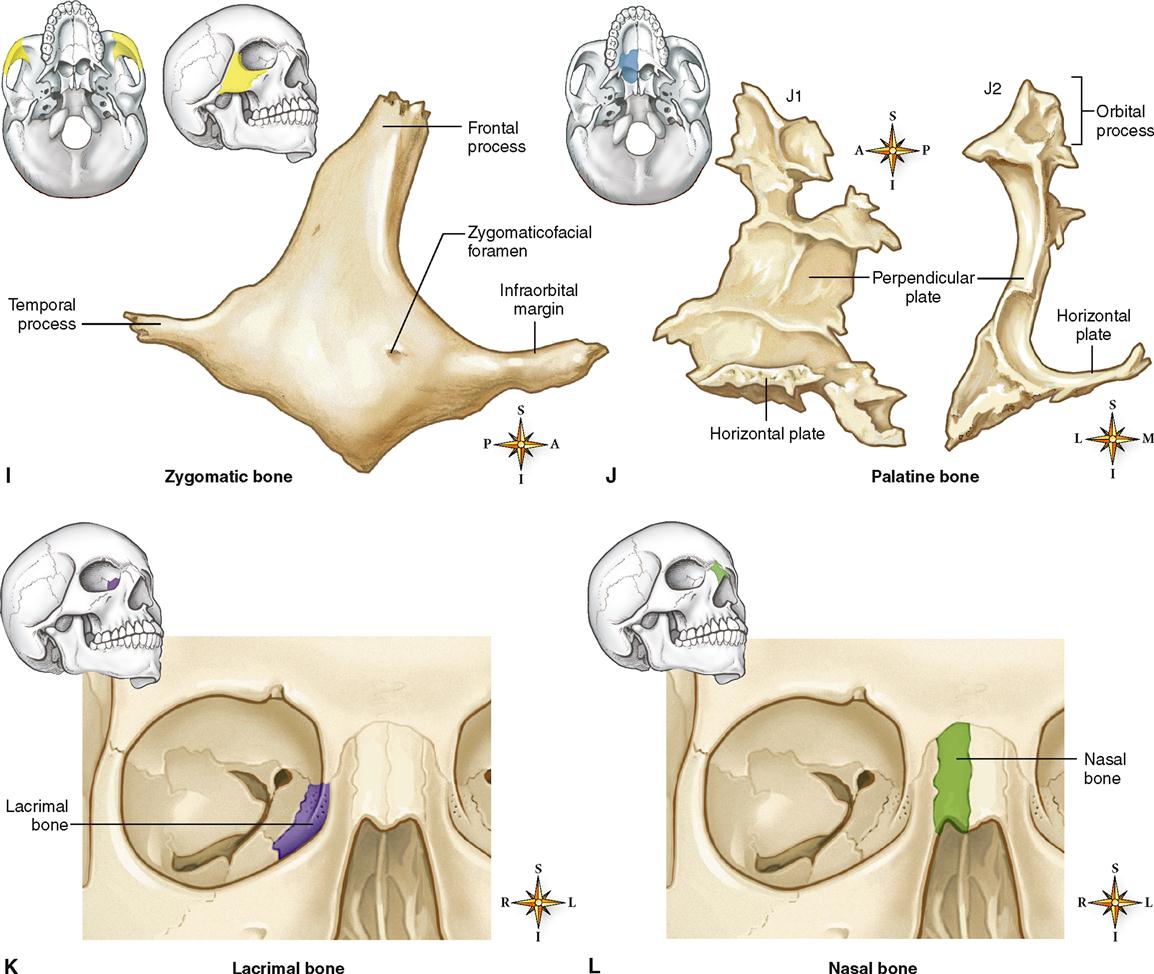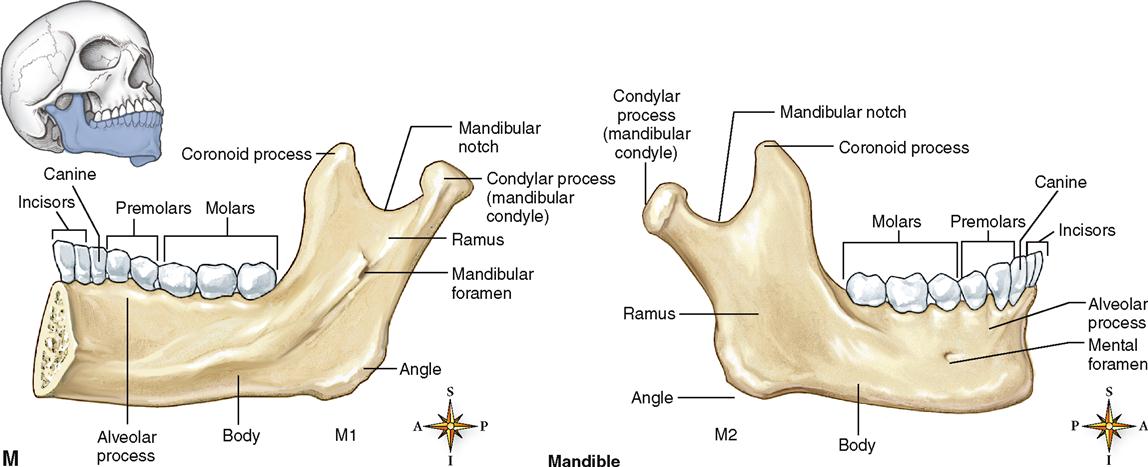Skeletal System
DIVISIONS OF THE SKELETON
The human skeleton consists of two main divisions—the axial skeleton and the appendicular skeleton (Figure 9-1). Eighty bones make up the axial skeleton. This includes 74 bones that form the upright axis of the body and 6 tiny middle ear bones. The appendicular skeleton consists of 126 bones—more than half again as many as in the axial skeleton. Bones of the appendicular skeleton form the appendages to the axial skeleton: the shoulder girdles, arms, wrists, and hands and the hip girdles, legs, ankles, and feet.
One of the first things you should do in studying the skeleton is to familiarize yourself with the names of the individual bones listed in Table 9-1. Next, look at Table 9-2, which lists some terms often used to name or describe bone markings—specific features on an individual bone. After this preparation, begin a step-by-step exploration of the skeletal system by studying the illustrations, text, and tables that constitute the rest of this chapter. To help you learn to distinguish between the names of bones and the names of their markings, the bone names are highlighted in a boldface font and the markings are shown in a normal font in illustrations and tables throughout this chapter.
TABLE 9-1
Bones of the Skeleton (206 Total)*

The numeral following each bone name is the typical number of bones found in the adult skeleton.
*An inconstant number of small, flat, round bones known as sesamoidbones (because of their resemblance to sesame seeds) are found in various tendons in which considerable pressure develops. Because the number of these bones varies greatly between individuals, only two of them, the patellae, have been counted among the 206 bones of the body. Generally, two of them can be found in each thumb (in the flexor tendon near the metacarpophalangeal and interphalangeal joints) and great toe, plus several others in the upper and lower extremities. Sutural bones (wormian bones), the small islets of bone frequently found in some of the cranial sutures, have not been counted in this list of 206 bones because of their variable occurrence.
TABLE 9-2
Terms Used to Describe Bone Markings
| TERM | MEANING |
| Angle | A corner |
| Body | The main portion of a bone |
| Border | Edge of a bone |
| Condyle | Rounded bump; usually fits into a fossa on another bone to form a joint |
| Crest | Moderately raised ridge; generally a site for muscle attachment |
| Epicondyle | Bump near a condyle; often gives the appearance of a “bump on a bump”; for muscle attachment |
| Facet | Flat surface that forms a joint with another facet or flat bone |
| Fissure | Long, cracklike hole for blood vessels and nerves |
| Foramen | Round hole for vessels and nerves pl., foramina) |
| Fossa | Depression; often receives an articulating bone (pl., fossae) |
| Head | Distinct epiphysis on a long bone, separated from the shaft by a narrowed portion (or neck) |
| Line | Similar to a crest but not raised as much (is often rather faint) |
| Margin | Edge of a flat bone or flat portion of the edge of a flat area |
| Meatus | Tubelike opening or channel (pl., meatus or meatuses) |
| Neck | A narrowed portion, usually at the base of a head |
| Notch | A V-like depression in the margin or edge of a flat area |
| Process | A raised area or projection |
| Ramus | Curved portion of a bone, like a ram’s horn pl., rami) |
| Sinus | Cavity within a bone |
| Spine | Similar to a crest but raised more; a sharp, pointed process; for muscle attachment |
| Sulcus | Groove or elongated depression pl., sulci) |
| Trochanter | Large bump for muscle attachment (larger than a tubercle or tuberosity) |
| Tuberosity | Oblong, raised bump, usually for muscle attachment; also called a tuber, a small tuberosity is called a tubercle |
A picture is worth a thousand words. The illustrations and tables contained in this chapter were carefully selected and compiled to assist you in visualizing and organizing the material discussed. If in addition to your textbook, you have access to individual bones or an articulated skeleton in a laboratory setting, frequent reference to chapter illustrations and tabular material will prove immensely helpful in your study efforts.
AXIAL SKELETON
Skull
Twenty-eight irregularly shaped bones form the skull (Figures 9-2 to 9-8). Figures 9-2 through 9-7 show the articulated bones of the skull in full or sectioned views.
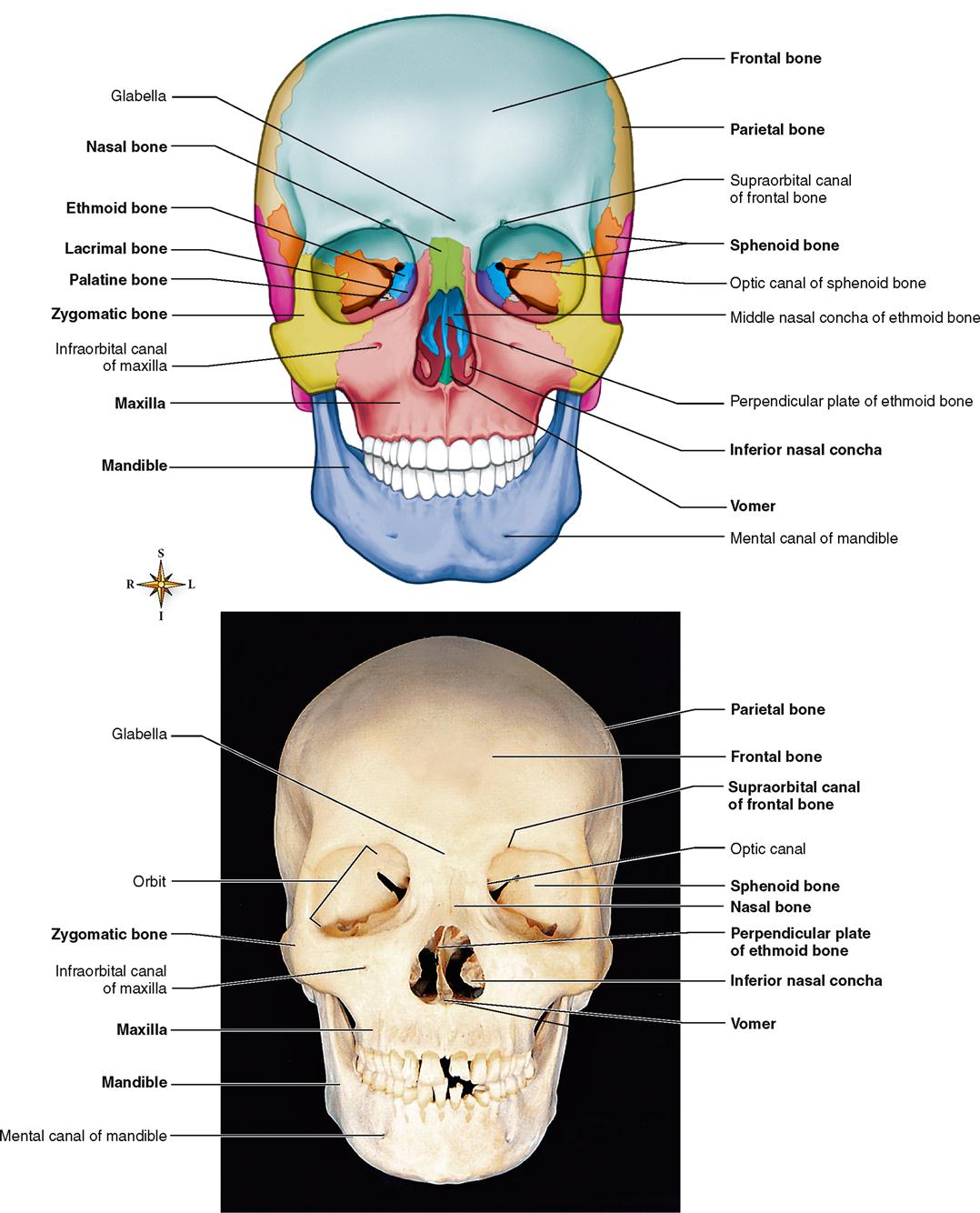
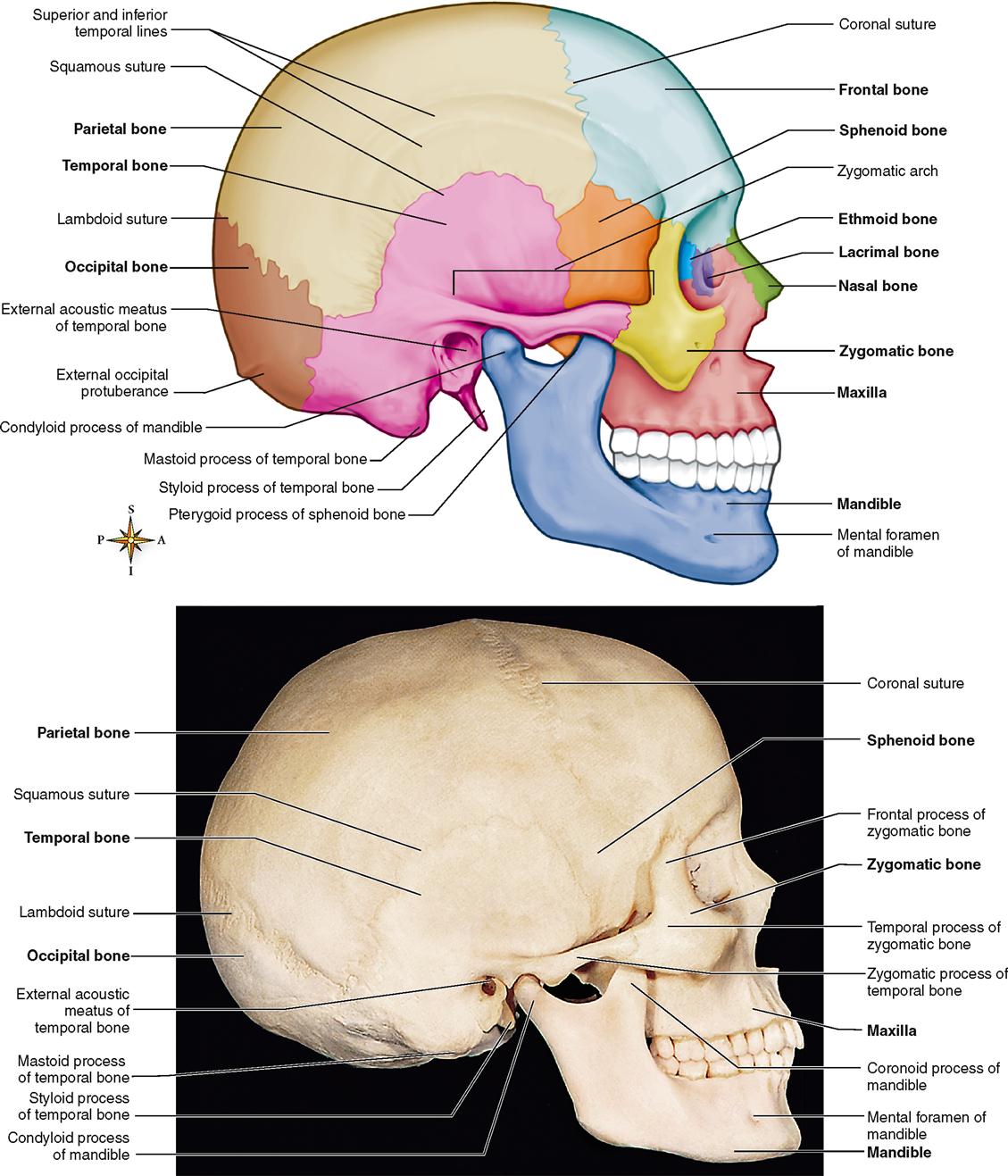
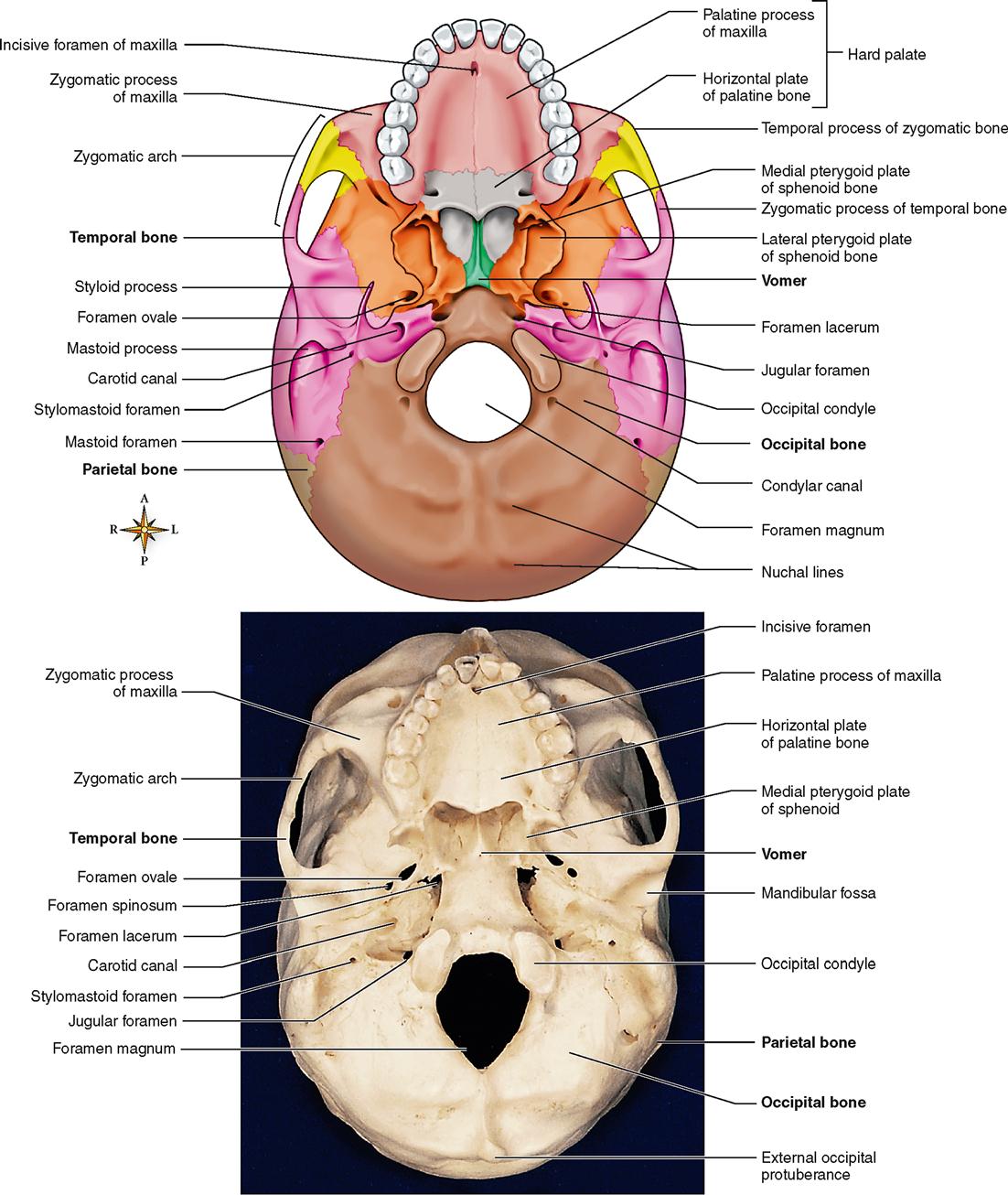
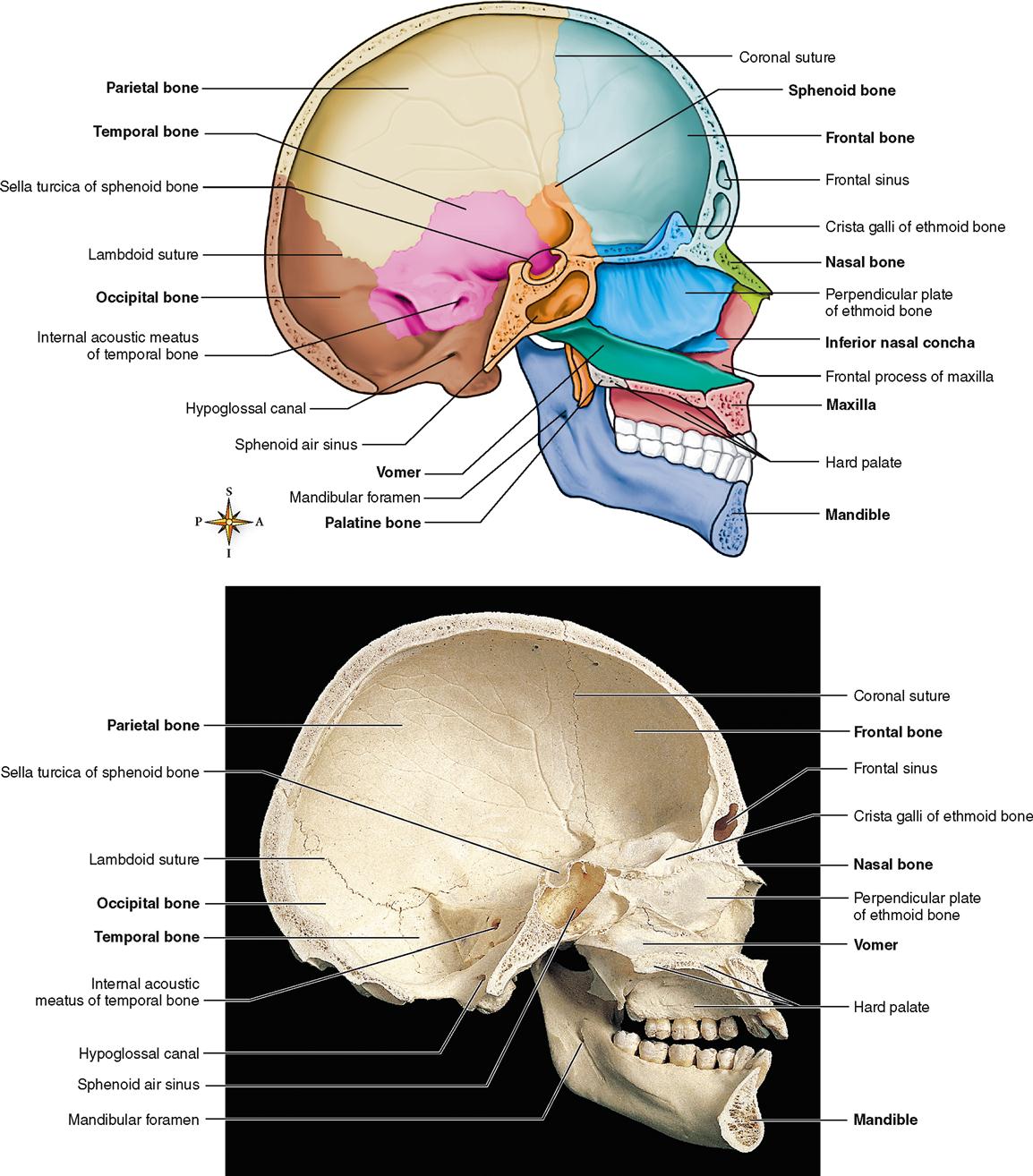
Figure 9-8 is a multipart series highlighting the individual bones and shows their relationship to the skull as a whole. As you study the skull, refer often to the illustrations and the descriptive information contained in Tables 9-3 to 9-5.
TABLE 9-3
Cranial Bones and Their Markings
| BONES AND MARKINGS | DESCRIPTION |
| Parietal | Prominent, bulging bones behind the frontal bone; forms the top sides of the cranial cavity |
| Temporal | Form the lower sides of the cranium and part of the cranial floor; contain the middle and inner ear structures |
| Squamous portion | Thin, flaring upper part of the bone |
| Mastoid portion | Rough-surfaced lower part of the bone posterior to the external acoustic meatus |
| Petrous portion | Wedge-shaped process that forms part of the center section of the cranial floor between the sphenoid and occipital bones; name derived from the Greek word for stone because of the extreme hardness of this process; houses the middle and inner ear structures |
| Mastoid process | Protuberance just behind the ear |
| Mastoid air cells | Mucosa-lined, air-filled spaces within the mastoid process |
| External acoustic meatus (or canal) | Tube extending into the temporal bone from the external ear opening to the tympanic membrane |
| Zygomatic process | Projection that articulates with the zygomatic (or malar) bone |
| Internal acoustic meatus | Fairly large opening on the posterior surface of the petrous part of the bone; transmits the eighth cranial nerve to the inner ear and the seventh cranial nerve on its way to the facial structures |
| Mandibular fossa | Oval-shaped depression anterior to the external acoustic meatus; forms the socket for the condyle of the mandible |
| Styloid process | Slender spike of bone extending downward and forward from the undersurface of the bone anterior to the mastoid process; often broken off in a dry skull; several neck muscles and ligaments attach to the styloid process |
| Stylomastoid foramen | Opening between the styloid and mastoid processes where the facial nerve emerges from the cranial cavity |
| Jugular fossa | Depression on the undersurface of the petrous part; dilated beginning of the internal jugular vein lodged here |
| Jugular foramen | Opening in the suture between the petrous part and occipital bone; transmits the lateral sinus and ninth, tenth, and eleventh cranial nerves |
| Carotid canal (or foramen) | Channel in the petrous part; best seen from the undersurface of the skull; transmits the internal carotid artery |
| Frontal | Forehead bone; also forms most of the roof of the orbits (eye sockets) and the anterior part of the cranial floor |
| Supraorbital margin | Arched ridge just below eyebrow; forms the upper edge of the orbit |
| Frontal sinuses | Cavities inside the bone just above supraorbital margin; lined with mucosa; contain air |
| Frontal tuberosities (tubers or eminences) | Bulge above each orbit; most prominent part of forehead |
| Superciliary arches (ridges) | Curved ridges caused by projection of the frontal sinuses; eyebrows lie superficial to these ridges |
| Supraorbital foramen (sometimes notch) | Foramen or notch in the supraorbital margin slightly medial to its midpoint; transmits supraorbital nerve and blood vessels |
| Glabella | Smooth area between the superciliary ridges and above the nose |
| Occipital | Forms the posterior part of the cranial floor and walls |
| Foramen magnum | Hole through which the spinal cord enters the cranial cavity |
| Occipital condyles | Convex, oval processes on either side of the foramen magnum; articulate with depressions on the first cervical vertebra |
| External occipital protuberance | Prominent projection on the posterior surface in the midline a short distance above the foramen magnum; can be felt as a definite bump |
| Superior nuchal line | Curved ridge extending laterally from the external occipital protuberance |
| Inferior nuchal line | Less well defined ridge paralleling the superior nuchal line a short distance below it |
| Internal occipital protuberance | Projection in the midline on the inner surface of the bone; grooves for the lateral sinuses extend laterally from this process and one for sagittal sinus extends upward from it |
| Sphenoid | Keystone of the cranial floor; forms its midportion; resembles a bat with wings outstretched and legs extended downward posteriorly; lies behind and slightly above the nose and throat; forms part of the floor and sidewalls of the orbit |
| Body | Hollow, cubelike central portion |
| Greater wings | Lateral projections from the body; form part of the outer wall of the orbit |
| Lesser wings | Thin, triangular projections from the upper part of the sphenoid body; form the posterior part of the roof of the orbit |
| Sella turcica | Saddle-shaped depression on the upper surface of the sphenoid body; contains the pituitary gland; literally “Turkish saddle” |
| Sphenoid sinuses | Irregular mucosa-lined, air-filled spaces within the central part of the sphenoid |
| Pterygoid processes | Downward projections on either side where the body and greater wing unite; comparable to the extended legs of a bat if the entire bone is likened to this animal; form part of the lateral nasal wall |
| Optic canal | Opening into the orbit at the root of the lesser wing; transmits the optic nerve |
| Superior orbital fissure | Slitlike opening into the orbit; lateral to the optic foramen; transmits the third, fourth, and part of the fifth cranial nerves |
| Foramen rotundum | Opening in the greater wing that transmits the maxillary division of the fifth cranial nerve |
| Foramen ovale | Opening in the greater wing that transmits the mandibular division of the fifth cranial nerve |
| Foramen lacerum | Opening at the junction of the sphenoid, temporal, and occipital bones; transmits a branch of the ascending pharyngeal artery |
| Foramen spinosum | Opening in the greater wing that transmits the middle meningeal artery to supply the meninges |
| Ethmoid | Complex irregular bone that helps make up the anterior portion of the cranial floor, medial wall of the orbits, upper parts of the nasal septum, and sidewalls and part of the nasal roof; lies anterior to the sphenoid and posterior to the nasal bones |
| Cribriform plate | Olfactory nerves pass through numerous holes in this horizontal plate |
| Crista galli | Meninges (membranes around the brain) attach to this process |
| Perpendicular plate | Forms the upper part of the nasal septum |
| Ethmoid sinuses | Honeycombed, mucosa-lined air spaces within the lateral masses of the bone |
| Superior and middle nasal conchae (turbi nates) | Help form the lateral walls of the nose |
| Ethmoidal labyrinth | Hollow lateral masses of the ethmoid; contain many air spaces (ethmoid cells or sinuses); the inner surface forms the superior and middle conchae |
TABLE 9-4
Facial Bones and Their Markings
| BONES AND MARKINGS | DESCRIPTION |
| Vomer | Forms lower and posterior part of nasal septum; shaped like the blade of a plough |
| Maxilla | Upper jaw bones; form part of the floor of the orbit, anterior part of the roof of the mouth, and floor of the nose and part of the sidewalls of the nose |
| Alveolar process | Archlike process that holds the tooth sockets |
| Maxillary sinus | Large, air-filled cavity within body of maxilla; lined with mucous membrane; largest of paranasal sinuses |
| Palatine process | Horizontal plate that projects inward from the alveolar process; forms anterior and larger part of hard palate |
| Infraorbital foramen | Hole on external surface orbit; transmits vessels and nerves |
| Lacrimal groove | Groove on inner surface; joined by similar groove on lacrimal bone to form bony space for the nasolacrimal duct |
| Zygomatic | Cheekbones; form part of floor and sidewall of eye orbit |
| Palatine | Form the posterior part of the hard palate, floor, and part of the sidewalls of the nasal cavity and floor of orbit |
| Horizontal plate | Joined to the palatine processes of the maxillae to complete part of the hard palate |
| Lacrimal | Thin platelike bones; posterior and lateral to nasal bones in medial wall of eye orbit; help form sidewall of nasal cavity (often missing in dry skull specimen) |
| Nasal | Pair of small bones that form the upper part of bridge of nose |
| Inferior nasal conchae (turbinates) | Thin scroll of bone forming shelf along inner surface of sidewall of nasal cavity; lies above roof of mouth |
| Mandible | Lower jawbone; largest, strongest bone of the face |
| Body | Main part of the bone; forms the chin |
| Ramus | Process, one on either side, that projects upward from the posterior part of the body |
| Condylar process | Part of each ramus that articulates with the mandibular fossa of the temporal bone |
| Neck | Constricted part just below the condyles |
| Alveolar process | Teeth set into this arch |
| Mandibular foramen | Opening on the inner surface of the ramus; transmits nerves and vessels to the lower teeth |
| Mental foramen | Opening on the outer surface below the space between the two bicuspids; transmits the terminal branches of the nerves and vessels that enter the bone through the mandibular foramen; dentists inject anesthetics through these foramina |
| Coronoid process | Projection upward from the anterior part of each ramus; the temporal muscle inserts here |
| Angle | Juncture of posterior and inferior margins of ramus |
TABLE 9-5
| FEATURE | DESCRIPTION |
| Sutures | Immovable joints between skull bones |
| Squamous | Line of articulation along the top curved edge of the temporal bone |
| Coronal | Joint between the parietal bones and frontal bone |
| Lambdoid | Joint between the parietal bones and occipital bone |
| Sagittal | Joint between the right and left parietal bones |
| Fontanels | “Soft spots” where ossification is incomplete at birth; allow some compression of the skull during birth; also important in determining the position of the head before delivery; six such areas located at angles of the parietal bones |
| Anterior (or frontal) | At the intersection of the sagittal and coronal sutures (juncture of the parietal bones and frontal bone); diamond shaped; largest of the fontanels; usually closed by 11.2 years of age |
| Posterior (or occipital) | At the intersection of the sagittal and lambdoid sutures (juncture of the parietal bones and occipital bone); triangular; usually closed by the second month |
| Sphenoid (or anterolateral) | At the juncture of the frontal, parietal, temporal, and sphenoid bones |
| Mastoid (or posterolateral) | At the juncture of the parietal, occipital, and temporal bones; usually closed by the second year |
| Air sinuses | Spaces, or cavities, within bones; those that communicate with the nose are called paranasal sinuses (frontal, sphenoidal, ethmoidal, and maxillary); mastoid cells communicate with the middle ear rather than the nose, so not included among the paranasal sinuses |
| Orbits formed by | |
| Frontal bone | Roof of the orbit |
| Ethmoid bone | Medial wall |
| Lacrimal bone | Medial wall |
| Sphenoid bone | Lateral wall |
| Zygomatic bone | Lateral wall |
| Maxilla | Floor |
| Palatine bone | Floor |
| Nasal septum formed by | Partition in the midline of the nasal cavity; separates the cavity into right and left halves |
| Perpendicular plate of the ethmoid bone | Forms the upper part of the septum |
| Vomer | Forms the lower, posterior part of the septum |
| Cartilage | Forms the anterior part of the septum |
| Sutural (wormian) bones | Small islets of bone in sutures; vary greatly from person to person |
| Malleus, incus, stapes | Tiny bones, referred to as auditory ossicles, in the middle ear cavity in the temporal bones; resemble, respectively, a miniature hammer, anvil, and stirrup |
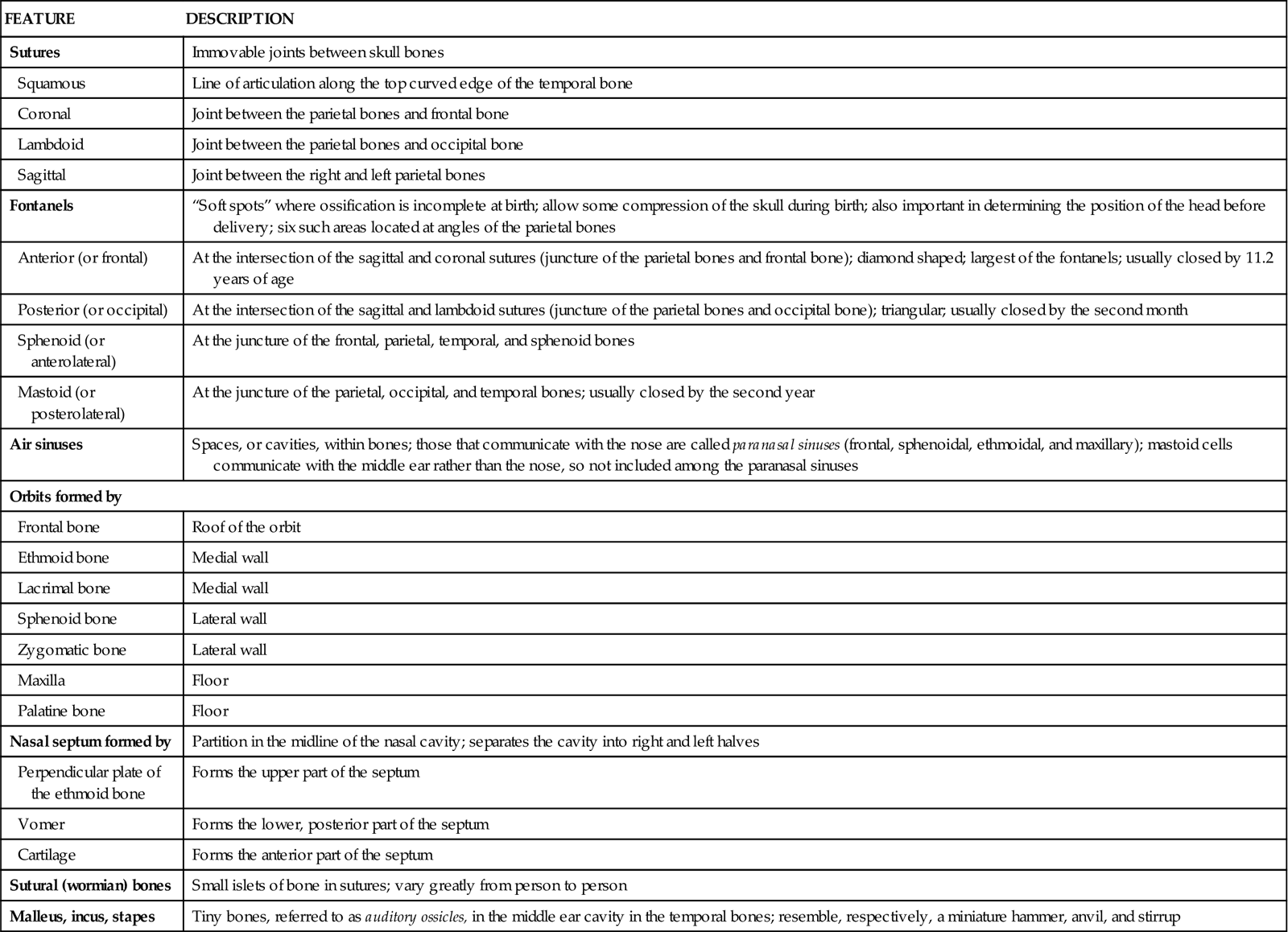
The skull consists of two major divisions: the cranium, or brain case, and the face. The cranium is formed by eight bones, namely, the frontal, two parietal, two temporal, the occipital, the sphenoid, and the ethmoid (Table 9-3). The 14 bones that form the face are the two maxillae, two zygomatic (malar), two nasal, the mandible, two lacrimal, two palatine, two inferior nasal conchae (turbinates), and the vomer (Table 9-4). Note that all the facial bones are paired except for the mandible and vomer. All the cranial bones, on the other hand, are single (unpaired) except for the parietal and temporal bones, which are paired. The frontal and ethmoid bones of the skull help shape the face but are not numbered among the facial bones.
CRANIAL BONES
The frontal bone forms the forehead and the anterior part of the calvaria or top of the cranium (see Figure 9-8, C). It contains mucosa-lined, air-filled spaces, or sinuses—the frontal sinuses. The frontal sinuses, with similar sinuses in the sphenoid, ethmoid, and maxillae, are often called paranasal sinuses because they have narrow channels that open into the nasal cavity (Figure 9-9). The paranasal sinuses are also discussed in Chapter 26, p. 802. A portion of the frontal bone forms the upper part of the orbits. It unites with the two parietal bones posteriorly in an immovable joint, or suture—the coronal suture. Several of the more prominent frontal bone markings are described in Table 9-3.
The two parietal bones give shape to the bulging topside of the cranium (see Figure 9-8, A). They form immovable joints with several bones: the lambdoid suture with the occipital bone, the squamous suture with the temporal bone and part of the sphenoid, and the coronal suture with the frontal bone.
The lower sides of the cranium and part of its floor are fashioned from two temporal bones (see Figure 9-8, B). They house the middle and inner ear structures and contain the mastoid sinuses, notable because of the occurrence of mastoiditis, an inflammation of the mucous lining of these spaces (see Mechanisms of Disease, pp. 264–265). For a description of several other temporal bone markings, see Table 9-3.
The occipital bone creates the framework of the lower, posterior part of the skull (see Figure 9-8, D). It forms immovable joints with three other cranial bones—the parietal, temporal, and sphenoid—and a movable joint with the first cervical vertebra. Table 9-3 lists a description of some of its markings.
The shape of the sphenoid bone resembles a bat with its wings outstretched and legs extended down and back. Note in Figures 9-4 and 9-8, E, the location of the sphenoid bone in the central portion of the cranial floor. Here it serves as the keystone in the architecture of the cranium and anchors the frontal, parietal, occipital, and ethmoid bones. The sphenoid bone also forms part of the lateral wall of the cranium and part of the floor of each orbit (see Figures 9-2 and 9-3). The sphenoid bone contains fairly large mucosa-lined, air-filled spaces—the sphenoid sinuses (see Figure 9-6). Several prominent sphenoid markings are described in Table 9-3.
The ethmoid, a complex, irregular bone, lies anterior to the sphenoid but posterior to the nasal bones. It helps fashion the anterior part of the cranial floor (see Figures 9-4 and 9-8, F), the medial walls of the orbits (see Figures 9-2 and 9-7), the upper parts of the nasal septum (see Figure 9-2) and the sidewalls of the nasal cavity (Figure 9-10), and the part of the nasal roof (the cribriform plate) perforated by small foramina through which olfactory nerve branches reach the brain (Box 9-1). The lateral masses of the ethmoid bone are honeycombed with sinus spaces called ethmoid air cells (see Figure 9-9). For more ethmoid bone markings, see Table 9-3.
